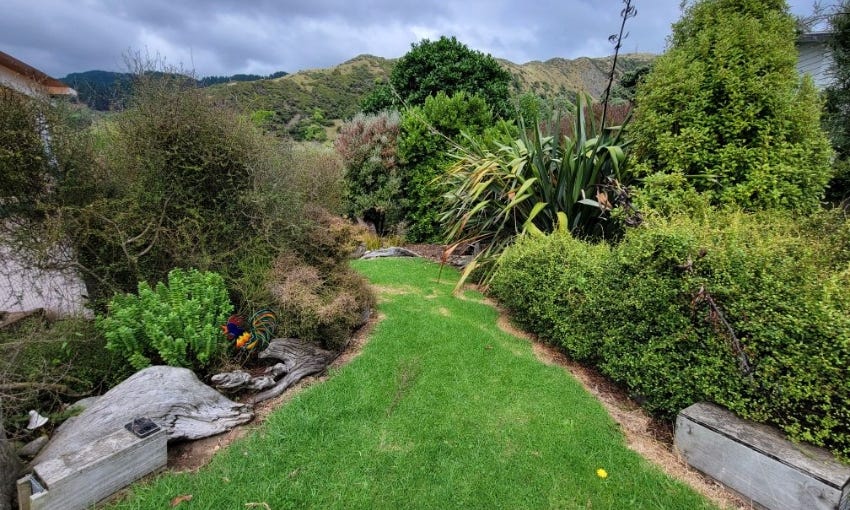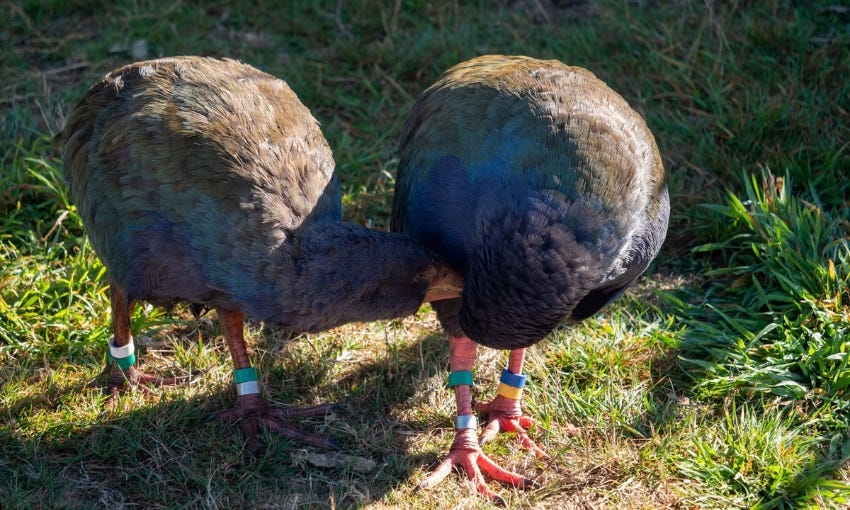How to boost your backyard biodiversity
You don’t need to go to wildlife sanctuaries to see native birds, bugs and reptiles.
Kia ora! Welcome to Future Proof brought to you by Electric Kiwi.
Amelia Geary has planted around 100 different native plant species in her backyard. Image credit: Amelia Geary.
Recently I wrote a feature for New Zealand Geographic on weeds – it turns out, a lot of our pest plants started out as garden favourites before jumping the fence to wreak havoc on native ecosystems. So this week I wanted to flip the bad backyards narrative, and see how our gardens can be havens for native biodiversity.
Make layers
Margaret Stanley, an ecologist at the University of Auckland, says it’s all about the layers: shrubbier plants, grasses and herbs underneath a canopy provide homes for insects, which in turn provide much needed protein for birds. “The more you have different layers, the more you get those different birds, like pīwakawaka and riroriro,” Stanley says. “Plants like cabbage trees are underappreciated because they’re very narrow and they don't take up much space in the garden, but they actually provide heaps of habitat for invertebrates, as well as nectar and fruit for birds,” she says.
‘Plant the tree you want to see in 20 years’
Amelia Geary, who lives in Paekākāriki on a quarter-acre block, was inspired to revamp her backyard after hearing lizards rustling in a flax bush, and mowing her lawn for the first time. “It took me three hours and I was like, no. This has to end,” she says. In the areas closest to the beach, Geary chose to replace grass with hardy plants that could survive in sandy soil and the harsh coastal environment – species like spinifex, pīngao, and dune coprosmas. Shrubs and more woody vegetation dominate the opposite end of the garden. She was careful to plant both male and female coprosmas, so they’d fruit, providing kai for the lizards and birds. She even established native mistletoe – a group of plants which have declined considerably since the early 1900s.
Know what you want to protect
The planting – of more than 100 different native species – was just the first step. “I take pest control very seriously. I have about 30 traps, and three cameras for surveillance,” Geary says. “I’m trying to protect the lizards in particular, so I’m trapping for mice, hedgedevils [hedgehogs] and rats.” Once dispatched, the pests are buried in the garden. “Never underestimate the value of a corpse. I caught 35 hedgedevils in one year, their nutrients are now powering the biodiversity that would have otherwise been in their bellies.”
There are other little changes you can make to welcome wildlife, such as constructing rock piles for reptiles, or installing bug hotels for wētā – like Holly Neill, whose impressive backyard transformation was profiled by the Predator Free Trust last year. Ultimately, it’ll be the combination of lots of people taking care of their small patch that will boost our wildlife. “If we've got all these little patches throughout the city, we can use our backyards to create corridors that allow biodiversity to move through, effectively making bigger habitat,” Stanley says.
Unexpected treasures
The efforts pay off. Geary’s resident northern grass skinks are enjoying their renovated and expanded habitat. But it’s the booming native invertebrate population that has captivated her. “It’s absolutely riddled with tree wētā, stick insects, moths… so many moths! My favourite time is to go out in the evening after dark on a calm still night with my head torch and spy all the fat caterpillars munching around the Muehlenbeckia.” Stanley, too, has been pleasantly surprised by the variety of invertebrates she now sees. “We’re actually getting beetles and moths. Not just flies!”
Join Electric Kiwi broadband in March and be in to win your first 12 months of broadband free. Plus, a guaranteed 2 months of free fibre! From just $2.65 per day, no contracts and a free Orbi WiFi 6 router. T&Cs and eligibility criteria apply.
‘Everything, everywhere, all at once’
The top UN boss invoked the name of the Oscar-winning film to describe the kind of climate action we need, following publication of the latest “stark” IPCC report. As Stuff’s Eloise Gibson explains, this report is a ‘One ring to rule them all’ synthesis of evidence collated in three earlier IPCC reports, covering the physics behind climate change, human impacts, and solutions. The release of the report was delayed as nations quibbled over wording, but Professor Bronwyn Hayward, a member of the core IPCC writing team, says it’s significant that countries agreed on the need for strong action this decade. This morning’s Bulletin analyses what the report means for New Zealand, while Toby Manhire investigates whether the data supports a “climate election” for 2023.
It’s never too late for climate action
We’ve already warmed the planet by 1.1°C, and the viability of the oft-cited 1.5°C limit is under intense scrutiny, the Financial Times reports. But it will never be too late to take climate action. “If we act now, we can still secure a liveable sustainable future for all,” says IPCC chair Hoesung Lee. “Not too late” is the tagline of a new project by Rebecca Solnit and Thelma Young Lutunatabua, aiming to bring new people into the climate movement, and reinvigorate those worn down by relentless bad news. And if you have someone in your life who insists that the climate has always been changing, or that volcanoes and solar flares are responsible for global heating, check out this misinformation-debunking explainer.
Climate actions vs… the right to park on the street?
Speaking of climate action, Mediawatch’s Hayden Donnell rightly points out that the media (and I’d contend, a decent chunk of the wider public) are keen on climate action in an abstract sense, but struggle to support tangible initiatives. For example, cycling is a tangible climate-positive action. Yet it’s difficult to combine cycling with public transport in Auckland, Tommy de Silva writes for The Spinoff. Elsewhere, cycle lane proposals in both Auckland and Wellington have attracted vocal naysayers at public meetings this week. Simon Wilson writes in the Herald (paywall) about the Great North Road proposal (which, as a former local to the area, sounds bloody fantastic). Meanwhile, opponents of Wellington’s newest protected cycleway – which would see removal of some on-street carparks – claim it will impact the “liveability” of the area. Evidence clearly shows that removing carparks to make way for cyclists and pedestrians produces positive impacts. (The Wellington cycleway is still open for consultation here.)
A message from Toby Manhire, editor-at-large and host of podcast Gone by Lunchtime.
Independent journalism is never more important than during an election year and we want to cover Election 2023 with rigour, range and humour. To do that, we need your help. Support our mahi by making a donation today.
More stories:
Urban green space has declined across three of New Zealand’s biggest cities, a new report finds
From April, Aucklanders will have a new kerbside bin especially for food scraps, and it could reduce waste going to landfill by around 45%
Science writer and historian Rebecca Priestley traces the story of our forest giants, kauri, and kauri dieback in this lovely piece for E-Tangata
President Biden has approved the massive oil drilling project in Alaska called Willow, directly contradicting his campaign promise of no new fossil fuels on federal land
This public swimming pool in the UK is kept cosy using the excess heat from a mini data centre
The Lake Onslow hydro scheme would cost $15.7 billion and would be completed in the mid-2030s, government announces
Thousands of birds die from avian botulism due to polluted waters at Whangamarino wetlands
After a Guardian investigation found it was flawed, the world’s biggest provider of rainforest carbon offsets will be phasing out and replacing their programme by mid-2025
A ProPublica investigative series examines how deforestation could lead to the next pandemic
A beautiful long-read from one of my absolute favourites, Elizabeth Kolbert, on caterpillars and the eccentric people who study them
These chunky rainbow chooks need names. Image credit: Orokonui Ecosanctuary.
To finish this edition, Orokonui Ecosanctuary in Dunedin wants your name suggestions for their pair of takahē chicks “before they head off for redder tussocks”. The six-month old duo are the offspring of rockstar parents Waimarie and Bennet, who had to contend with a late-season snow and “hundreds of curious visitors” while raising them. Make a name suggestion (gender-neutral preferred) here by 16 April. And in more Dunedin wildlife news, Pesky Pete the red-billed gull has been loitering around the Dunedin Wildlife Hospital despite not actually needing medical care. “We have a real soft spot for Pesky Pete, he is such a character. But it would be better for us and our other gull patients if he would just move on.”
Maybe Pete should find a gull-friend… let’s hope his peskiness peters out!
Ellen
Got some feedback about Future Proof or topics you’d like covered? Get in touch with me at futureproof@thespinoff.co.nz












